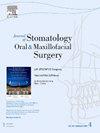A simple and free software-based inferior alveolar nerve protector surgical guide in bilateral sagittal split osteotomy.
IF 1.8
3区 医学
Q2 DENTISTRY, ORAL SURGERY & MEDICINE
Journal of Stomatology Oral and Maxillofacial Surgery
Pub Date : 2024-09-07
DOI:10.1016/j.jormas.2024.102068
引用次数: 0
Abstract
OBJECTIVES This technical note introduces a novel concept of a alveolar inferior nerve protector guide during orthognathic surgery based on a free-software creation and printing. TECHNICAL NOTE Orthognathic surgery using Virtual Surgical Planning software like Dolphin Imaging ® v 11.9 facilitated a bimaxillary procedure with mandible advancement and occlusal plane correction, later followed by 3D printing of splints. The process involved importing a composite skull with osteotomies into Blender ® software, where solids were added and edited to match Dolphin's osteotomies, ensuring bone contact without distortion. The guide creation was performed adhering to bilateral sagittal split osteotomy principles, maintaining precision, resulting in preserved inferior alveolar nerve and faster operation times compared to non-guided procedures, as demonstrated by postoperative CT scans. CONCLUSIONS Integrating advanced tools like Blender software into maxillofacial surgery represents a significant advancement. Despite challenges like the absence of specific manuals for this purpose in Blender, using such software offers innovative and cost-effective solutions. Developing user-friendly resources tailored to surgical applications such as a protector guide within Blender can enhance its usability and improve surgical outcomes and patient care, leading to groundbreaking advancements in maxillofacial surgery.基于软件的下牙槽神经保护器手术指南,用于双侧矢状劈开截骨术。
技术注释使用Dolphin Imaging ® v 11.9等虚拟手术规划软件进行正颌外科手术时,可进行下颌骨前移和咬合面矫正的双颌手术,随后进行夹板的三维打印。该过程包括将带有截骨的复合头骨导入Blender ®软件,在其中添加实体并进行编辑,以与Dolphin的截骨相匹配,确保骨接触不变形。正如术后CT扫描所显示的,与无引导手术相比,该引导创建过程遵循了双侧矢状劈开截骨原则,保持了精确性,从而保留了下牙槽神经并缩短了手术时间。尽管存在一些挑战,如 Blender 中没有专门的使用手册,但使用此类软件可以提供创新且经济高效的解决方案。开发适合外科应用的用户友好型资源(如 Blender 中的保护器指南)可以提高其可用性,改善手术效果和患者护理,从而在颌面外科领域取得突破性进展。
本文章由计算机程序翻译,如有差异,请以英文原文为准。
求助全文
约1分钟内获得全文
求助全文
来源期刊

Journal of Stomatology Oral and Maxillofacial Surgery
Surgery, Dentistry, Oral Surgery and Medicine, Otorhinolaryngology and Facial Plastic Surgery
CiteScore
2.30
自引率
9.10%
发文量
0
审稿时长
23 days
 求助内容:
求助内容: 应助结果提醒方式:
应助结果提醒方式:


